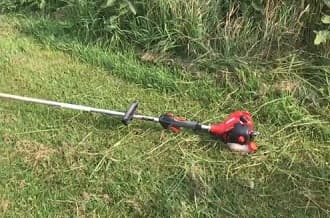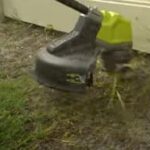As an Amazon Associate, this site earns commissions from qualifying purchases. For more information click here.
Whether you call them weed eaters, weed wacker or string trimmer, there is no question this is a great tool for cutting weeds. But how long can you expect the cutting line to last? Is the string meant to last for years or do you have to replace it regularly? That is what we answer here.
It is natural for weed eater lines to wear out with use. But the line wears out more quickly if you use it to trim large weeds. The string can also break if it rotates too fast or you trim it against a hard surface.
What Causes String Trimmer Lines to Break?
A weed eater is equipped with a spinning line or string. Using centrifugal force, the line stiffens the faster it rotates. This allows the line to cut through weeds, grass and other materials.
The thicker the line, the longer it is going to last. But the trimmer line is going to turn brittle and break due to wear and tear. There are also specific instances where the line is going to fray sooner.
Cutting woody plants and thick weeds. String trimmers are meant to trim weeds, grass and small plants. Large, thick weeds and plants require more effort from the line and the engine. This not only wears out the line but also the engine.
Trimming against hard surfaces. A fast spinning line gets worn out when it makes contact with rocks, wood or other hard surfaces.
To prevent rapid wear, slowly move the trimmer head towards the weeds. Slide the trimmer head and trim with the tip.
Ease up on the throttle when trimming thick material or against rocks. That will give you more control over the line speed. Avoid moving too fast because the line might brush against the rocks. If the line is spinning too fast it could get snapped.
Line is too thin. Check your owner’s manual to find the right size for your trimmer. Just like string trimmer attachments you have to use the right one for your specific make and model.
How Long Does a String Trimmer Line Last?
An average weed eater line lasts 3 to 6 months, assuming it is used weekly. A heavily used trimmer line could run out in 2 months though. It depends on the line quality, how often it is used and the materials it is cutting.
There are other factors that determine how long a weed eater lasts. Understanding what these are can help you prolong its lifespan.
Line quality. Some strings are better than others, period. Size matters yes, the thicker ones last longer But even large lines are not made equal. The A Anleolife lines are well known for their durability.
Most weed eater spools are universal, but make sure the size is right for your trimmer. Even thick lines are going to run out eventually though, but it is better than a thin string.
Usage. If you cut weeds weekly, the line should last for at least three months. If you have a small yard and trim only on occasion, it could be up to 6 months. After that you should replace the line before it gets frayed.
Maintenance. A well-maintained trimmer line is good for the long term. Soaking it in water and regular cleaning are essential. But if the line is always exposed to the sun and never cleaned, it will get frayed or broken sooner than later.

When Should You Replace Weed Eater Lines?
A trimmer line should be replaced every 3-6 months. This is only a general guideline as it depends on its condition. If your weed eater is used daily to trim thick weeds and plants, even a thick line of spool will not last long.
The user manual should have information on how often to replace the line. If there is none, you can determine the replacement date based on several factors.
Regardless how often you use the trimmer, replace it after 6 months. By this time the line is close to the end of its lifespan. Do not wait for the line to break while you are using it. Even if you use the trimmer weekly, the 6 month replacement rule is applicable.
For heavily used weed eaters, replace the line sooner. If you have a large garden and cut through very thick weeds, it is not unusual to replace the line every 1-2 months. If the line is affecting performance, get a new one.
Why Weed Eater Lines Run Out Fast
Weed eater lines run out quickly because of heavy use, a faulty spool, defective hub or the guard has been removed or broken. How you solve this depends on the cause.
The hub is damaged. Any damage to the hub, spool or any trimmer part is going to affect the line. String trimmer parts are closely integrated, and if one gets broken, the rest are affected. Turn the trimmer off if you suspect there is damage somewhere. Fix it first before trying the trimmer again.
The line is poorly maintained. Do not let the line get entangled. Clean the trimmer head after each use and remove all debris. Do not expose the line to intense heat.
The line is flimsy. Flimsy, low quality lines fray quickly. It is better to invest in a high quality line that will last longer. Cheap lines cost more because they wear out faster. Your weed trimmer brand probably makes their own line and there are third party options too. Just do not settle for low quality. A reliable option are theYCDAQCW strings which works with a lot of weed eaters.
You use a lot of line. If you cut a lot of weeds, grass and plants on rocky surfaces, it is going to use a lot of string. Thicker lines last longer but it is going to run out as well. If you are always running out of lines, get a larger spool.
How to Make Weed Eater Lines Last Longer
So far we have established that yes, weed eater lines do break. But there are ways to make the line last. Here are some tips.
Use round-shaped lines. Square and star-shaped lines wear out faster. This is a general rule as it also depends on the manufacturer. If you buy from a reputable brand, the line should last for months regardless of shape.
Keep the line parallel to the ground. This is important when hitting the spool to get more line. This also prevents the line from making contact with the surface. Instead it strikes the weeds and plants.
Thicker lines last longer. For light grass trims, the standard 0.065-0.085 inch size is good enough. For thicker material, anything at 0.085 or higher is sufficient.
Keep in mind that the thicker the line, the slower it will spin. At least with low to mid-voltage string trimmers. Get a high voltage trimmer if you want thick lines that can spin fast.
Soak the line in water. This is one of the simplest but most effective ways to make a weed eater line last a long time.
Fill a bucket with water. A 3-5 gallon size bucket should be enough for most spools. The water should be lukewarm.
Drop the spool full of lines in the bucket. Leave the line there for 24-48 hours. Next, pull the lines out. Dry it with a towel, careful not to damage it. Put the line back on the weed eater after it is completely dry.
A lot of people swear by this method and there is basis for it. String trimmer lines are usually monofilament, which loses moisture over time.
Immersing the line in water for 24-48 hours restores the moisture. Water makes the lines more durable and less prone to breaking.
You do not have to soak the line in water all the time. Once every 1-2 months is enough. With most monofilament trimmer lines, this makes a difference in terms of durability and the longevity

I love the outdoors and all the tools for maintaining gardens, yards and lawns. The only thing I am more passionate about is sharing what I know about garden and outdoor equipment.


